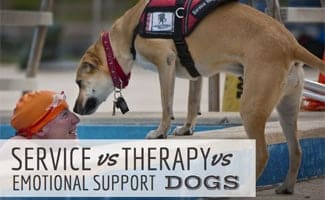When you purchase through links on our site, we may earn a commission. Here’s how it works.

Are you using the terms service dog, therapy dog, and emotional support dog interchangeably? Did you know there’s a difference between these three types of dogs? To help clarify, we’ve written this article to explain where you may see a certain type of dog and when someone may need one.
Therapy Dog vs Service Dog vs Emotional Support Dog
What’s the difference between service, therapy & emotional support dogs?
- A therapy dog is trained to provide comfort and affection to people in hospice, disaster areas, retirement homes, hospitals, nursing homes, schools, and more.
- A service dog is certified and trained to help people with disabilities, such as visual impairments, mental illnesses, seizure disorders, diabetes, etc.
- An emotional support animal (ESA) provides their owners with therapeutic benefits through companionship. They do not require training, but you may be screened by a mental health professional to see if you qualify.
Service Dog Training
There are two main types of service dogs:
- Those that assist people with physical impairments (such as visually impaired or unable to perform certain tasks because of an illness or injury)
- Psychiatric service dogs, help people with mental disabilities, such as anxiety, depression, post-traumatic stress disorder, etc.
Both types have the same legal rights. The option to use a service dog is given under the Americans with Disabilities Act (ADA) and by local governments.
According to the ADA, service animals are working animals, not pets. They have been specifically trained to perform tasks related to the disabled person’s specific disabilities.
For example, if you are diabetic, you may have a dog who can detect when your blood sugar level is too low or high. Training can be done by you, a friend, a family member, or a professional trainer.
Service dogs must be:
- On a leash, harnessed, or tethered (unless it interferes with the service animal’s work or the individual’s disability).
- Controllable and know verbal/hand signals such as sit, stay, come, down, and heel.
- Housebroken and potty trained.
Simply having a disability isn’t reason enough to categorize your own dog as a service dog. Your service dog must be able to complete tasks that you are unable to complete yourself.
Document Training
Be sure to document training dates and accomplishments in a notebook or online document. Not only will this help you through training, but it will also provide a paper trail for your service dog. Having a professional training certificate or video recording can offer validity if your service dog certification is challenged, but it is not required. If you have a psychiatric service dog, a doctor’s note may be required for airline travel and other public areas.
Service Dog Laws
There are two key service dog laws to keep in mind. First, service dogs have to be allowed into businesses, and it is illegal for someone to ask about your disability. However, someone can ask if the pet is required due to a disability or what tasks your service dog is able to perform. Second, pretending to be disabled to gain access to an area is against the law. Service dog registration is not required by the ADA.
What Not To Do Around Service Dogs
Please do not pet service animals while they are working. The news story below has some more tips based on a man’s experience with a service dog.
What Do Therapy Dogs Do?

Therapy dogs are used in facilities to comfort people and give affection. Spending time with a therapy dog has been shown to lower blood pressure and heart rate, reduce anxiety, and increase endorphins and oxytocin. Therapy dogs do not have to be trained to perform specific tasks like service dogs.
Therapy Dog Training
Are you asking yourself, “Can my dog be a therapy dog?” It’s important to first point out that not all dogs are good candidates to be therapy dogs. Therapy dogs should be naturally calm as well as affectionate and friendly to strangers. They need to be obedient in addition to having regular wellness check-ups and also be well-groomed for each visit.

To train a dog to be a therapy dog, you may wish to do the following:
- Socialize your dog with new people, places, and things
- Complete obedience training with commands like “look” and “leave it” in addition to teaching them to not jump on people and more
- Enroll your dog in a therapy dog class
- Register your dog with a national therapy dog organization
View Therapy Dog In Training Vest on Amazon
How To Certify A Therapy Dog
Depending on where you plan to take your therapy dog, you may not need to register him/her. Therapy dog certification can be achieved through various organizations, but we recommend the AKC.
To earn the AKC Therapy Dog title, you and your dog must do the following:
- Be certified by a therapy dog organization that is recognized by the AKC
- Perform the required number of visits:
- AKC Therapy Dog Distinguished (THDD) – 400 visits
- AKC Therapy Dog Excellent (THDX) – 200 visits
- AKC Therapy Dog Advanced (THDA) – 100 visits
- AKC Therapy Dog (THD) – 50 visits
- AKC Therapy Dog Novice (THDN) – 10 visits
- A therapy dog must be registered with AKC (both purebred and mixed breed dogs are eligible)
Emotional Support Dogs
Emotional support dogs or emotional support animals (ESAs) provide comfort, a calming presence, and company. Emotional support dogs do not have access to all public areas. But they do qualify for no-pet housing. Housing authorities may request a physician’s letter because some have abused the use of emotional support dogs over the years.
ESA vs Service Animal For Flying
Service dogs are still allowed by airlines. Previously ESAs were allowed to fly in the cabin with documentation too. But in December 2020, the U.S. Department Of Transportation (DOT) announced it no longer considers ESAs a special assistance animal for air travel. As a result, it’s now up to the airlines to set their own ESA policies. Most major U.S. carriers are following the DOT guidelines and only allow trained service animals:
- Alaska – As of January 11, 2021, Alaska only accepts trained service dogs.
- American Airlines – As of January 11, 2021, travel for ESAs is no longer authorized.
- Delta – ESA reservations submitted and confirmed before January 11, 2021, are accepted. But, they no longer book new ESA reservations.
- Southwest – As of March 1, 2021, Southwest only accepts trained service dogs.
- Spirit – As of January 11, 2021, ESAs can travel onboard as pets only.
- United – Will honor ESAs for reservations purchased before January 11, 2021, for travel on or before February 28, 2021. After February 28, 2021, they will no longer allow ESAs.
Note: Pets (including ESAs) that meet an airline’s specific requirements may travel with you or in cargo but are subject to paperwork and fees.
Learn more about Flying With Dogs
There is no formal training needed to be an emotional support dog, which is why you may see some that are not that well-behaved. However, there are some characteristics you’ll want to know, so you have the best experience with your emotional support dog.
Characteristics To Look For In An Emotional Support Animal

Your emotional support dog should be devoted to you and responsive to your emotions and commands. The dog should also be calm and laid back. A rambunctious dog has the capability of becoming an emotional support dog, but it will require more training. It is recommended to look for a dog that is around one year old so you can build that relationship with him or her and have them be out of their curious puppy phase.
However, puppies can be emotional support animals as well. They’ll just need to be a breed that is people-oriented (e.g., Labrador Retrievers, Golden Retrievers, Goldendoodles, Poodles, etc.). Learn more about emotional support animals.
What Kind Of Dog Is Needed?
We thought it’d be fun to “quiz” you to see if you can distinguish which type of dog is appropriate for various scenarios. Test your knowledge below.
Q: What kind of dog helps a person when they need assistance with a disability while flying?
A: Service dog
Q: What kind of dog is needed at school to help children experiencing anxiety?
A: Therapy dog
Q: What kind of dog is needed to pull a wheelchair?
A: Service dog
Q: What kind of dog offers companionship in day-to-day activities for one person?
A: Emotional support dog
Q: What kind of dog is needed to protect someone who is having a seizure?
A: Service dog
Q: What kind of dog is needed to remind a person with mental illness to take their prescription?
A: Service dog
Q: What dog helps a person with autism?
A: Service dog
Q: What kind of dog works with numerous people?
A: Therapy dog
Q: What kind of dog calms a person with Post Traumatic Stress Disorder (PTSD)?
A: Service dog
Additional Support For Training Dogs
We hope this article sheds some light on the differences between service, therapy, and emotional support animals. We know it can be confusing, but it’s important to understand as there are various laws, certifications, and guidelines that each should adhere to. If you are looking to teach your dog to become one of these dogs, we recommend getting started first with some basic obedience training which you can do at home or virtually. Learn more about online dog training options.
Tagged With:

